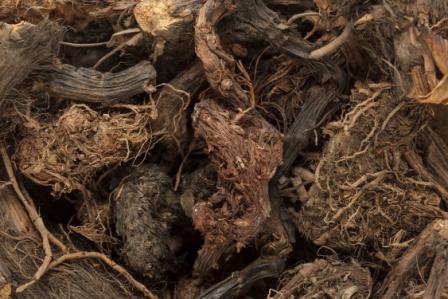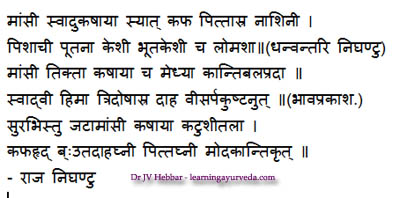Jatamansi – Benefits, Usage, Side Effects

Jatamansi is a famous Ayurvedic herb used in neuro-psychiatric diseases and skin diseases. It is known as Spikenard in English. Its botanical name is Nardostachys jatamansi DC. Its reference in Ayurveda is found since the times of Charaka and Sushruta.
Botanical Name-
Nardostachys Jatamansi Dc. [ N. Grandiflora Dc; Valeriana Jatamansi Auct. Non Jones.]
Family-Valerianaceae (Maamsi Kula)
Table of Contents
Varieties
Ra. Ni – Jatamamsi, Gandhamamsi, Akasa mamsi
Morphology
An erect perennial herb, grows up to 60 cm height with stout, woody root
Stem – With longitudinally nerved leaves
Inflorescence – Usually 1,3 5 flowered, dense cyme
Flower – Rosy, pale pink, or blue coloured pubescent
Fruit – 4 mm long, indehiscent, covered with minute hairs
Useful part – Rhizome
Jatamansi benefits
Asranashini – because of its bitter taste and Pitta balancing quality, it is widely used to purify blood. Hence useful in skin diseases.
Medhya – improves brain functions
Kantiprada – improves skin complexion and luster
Balaprada – improves strength and immunity
Dahanut – Because it is Pitta balancing, it relieves burning sensation, on external application.
Visarpakushtanut – useful in herpes and skin diseases
Bhutadahaghni – useful in psychiatric conditions.
Modakrut – useful in depression
The roots are cooling in nature and pacify Pitta dosha.
In North India, it is used as Bhootaghna, and they keep it beneath the bed of the young children so as to prevent evil spirits.
Jatamansi for skin
Jatamansi powder is frequently used along with saffron, turmeric etc skin benefiting herbs to make face pack / face cream or masks. This is known to improve skin glow and complexion
Jatamansi powder is frequently used along with saffron, turmeric etc skin benefiting herbs to make face pack / face cream or masks. This is known to improve skin glow and complexion.
It helps to lower blood pressure. It is used as an Ayurveda remedy for blood pressure.
It is used in traditional remedies to treat amenorrhoea. It induces periods. For this purpose, its traditional dose is – half a gram of powder, two times a day from seven days before menstruation.
It is extensively used in the treatment of headache and depression.
Its tablet – called Jatamansi Ghanvati is given in a dose of 1/2 – 1 tablet once or twice a day in the treatment of psychiatric disorders.
It is used in gastritis and bloating.
Home remedies
Some of the simple remedies and their health benefits are mentioned here below-
Insomnia, hair growth
1. Jathamamsi root oil for insomnia, hair growth, burning of the scalp etc:
Jatamamsi roots are soaked in water for a day. Next morning, it is made into paste and cooked with sesame oil and equal amount of decoction of the roots or water as medium, in mild intensity of heat till complete evaporation of moisture content. This is filtered and stored.
This oil is applied to the scalp in cases like loss of sleep, hair fall, burning of the scalp etc.
Sleep disturbance
2. Root powder of Jatamamsi with Khurasani yavani (Hyocymus niger Linn) seed powder for sleep disturbance:
Equal amounts of Jatamamsi and Khurasani oma are taken and fine powder is made. This is administered in the dose of 2-3 grams twice daily, especially during night time along with water.
This helps to get quality sleep.
Stress, hallucination
3. Jatamamsi decoction in stress, confusion, hallucination, vertigo etc:
20 grams of jatamamsi roots are taken and boiled with 200 ml of water and reduced to 50 ml. This is used for filtering during bed time. This is very effective in conditions like stress, confusion, hallucination, vertigo etc.
Headache, burning sensation of scalp
4. Root powder paste along with butter –application to the scalp for headache and burning of the scalp:
Dry roots are taken and rubbed well with ghee. To this little butter is mixed and applied to the middle of the scalp. This helps to reduce the burning of the head and relieve stress headache.
Click to consult Dr MS Krishnamurthy MD (Ayu), PhD
Sanskrit synonyms
Tapasvini – useful to improve brain functions and intelligence.
Jatamamsi, Vilomasa, Bhuta Jata – Its rhizomes have hairs, giving it a demon appearance.
Nalanda – Nalam Gandham Dadati – yields good aroma,
Pishita – muscular rhizome
Palamkasha – Reduce mamsa
naladdam – Rhizome has agreeable smell
Mata – Induce good sleep
Kiratini – Grows in Mountain Himalaya
misi – Rhizome is black in colour
Mura
Hindi name –Jatamasi
Telugu Name- Jatamansi
English Name- Spikenard
Marathi & Gujarati Name- Jatamansi
Tamil & Kannada & Malayalam Name- Jatamamsi

Classical categorization
Charaka-
Sajnasthapana – group of herbs used in restoring consciousness
Kandughna – a group of herbs used to relieve itching.
Tikta Skandha – bitter tasting group of herbs.
Susruta – Elajanadi Gana, Eladi gana
Vagbhata – Anjanadi Gana, Eladigana
Kaiyadeva Nighantu – Oshadhi Vargha
Sarvaushadhika Varga, Sugandhamalaka Varga
Different Varieties
In two to three contexts Susruta and Vagbhata described two varieties of Mamsi (S.S.KA. 6/15;7/23; S.S.Ut.60/47;62/30;5/2&6/38)viz; Jatamansi herb and Gandhamamsi (Jata and Bhutakesi) Bhutakesi or Gandhamamsi is identified with Selinum tennuirolium Wall.
In Raja nighantu, a third variety known as Akasa Mamsi is described. In Nighantu Ratnakaram three varieties viz. Sadharana Mamsi, Sugandha Mamsi & Aksamamsi – Suksma Mamsi are described.
(Reference: Illustrated Dravyaguna VIjnana, Vol. II, by Dr JLN Shastry)
Distribution
It is found in alpine regions of Himalaya at 11,0000-15000 ft; extending between Kumaon to Sikkim at 17000 feet and Bhutan.
This plant is not found in all geographical areas; in India especially it can be found in Kashmir. Or else in Nepal also this is found naturally. Usually it grows at the height of 2000-6000 meters.
Major chemical constituents
Actinidine, Carotene, Aristolens; Calarence, carenal, elemol, ,Droaristolene, B-eudesmol; Jatamols; A&B; Jatamansic acid, Jatamansone, Nardol, Nardostachonol, Nardostachone, Patchouli, Virolin, Angelivin, Jatamansin, Jatamansinol, Oroselol etc.(Reference: Illustrated Dravyaguna Vijnana, Vol. II, by Dr JLN Shastry)
Part used, dosage
Part Used– Rhizome, Jatamansi oil
Dosage- Powder -1-3 g in divided doses, along with honey, ghee or water.
The roots of the plant are used for preparing medicines and they appear shaggy with fragrance. Jatamamsin is the active constituent of the plant and it is a volatile oil with a very strong smell.
Substitute
Root of Cymbopogon schoenanthus spreng
Nynphoids macrspermum
Adulterants
Selinium vaginatum
Selinium tenuifolium
Medicinal qualities
Guna (qualities) –
Laghu – light to digest
Snigdha – oily, unctuous.
Taste – Tikta (bitter), Kashaya (Astringent) Madhura (sweet)
Vipaka – Taste conversion after digestion – Katu (pungent)
Veerya – Cold potency
Prabhava – special effect – Bhutaghna, Manasadoshahara – effective in neuro-psychiatric conditions.
Effect on Tridosha – It balances all the three doshas, but has special effect on Pitta and Kapha.
Jatamansi Side Effects
Special care is required while administering this medicine to people with high blood pressure.
People with heavy periods should avoid this herb during periods. It may increase menstrual flow.
On giving this medicine in excess dose, it may cause vomiting, twitching abdominal pain and purgation.
It is best avoided during pregnancy and lactation period.
It can be given to children only under medical supervision.
Interaction with medicines, supplements
Can Jatamansi be used for people suffering from hyperacidity?
Can this be used while taking Homeopathic medicine?
Yes. This product does not react with homeopathic medicine.
Can this medicine be continued while taking supplements like multivitamin tablets, Omega 3 fatty acids etc?
Yes. Generally, this product goes well with most dietary supplements. However, if you are taking more than one product per day, please consult your doctor for an opinion.
With western
medicines
Seek your
doctor’s advice if you are taking this product along with other western
(allopathic / modern) medicines. Some Ayurvedic herbs can interact with modern
medicine.
If both Ayurvedic and allopathic medicines are advised together, then it is
best to take Allopathic medicine first, wait for 30 minutes and then take the
Ayurvedic medicine.
Research
Effect on acute pancreatitis
Anti oxidant effect
Jatamamsi along with other herbs such as Vacha, Agaru, Sandalwood, Camphor etc. is used for fumigation of fermentation vessels, in the preparation of Arishta and Asava – Alcoholic Ayurvedic medicines.
Ayurveda medicines
Ayurveda medicines with Jatamansi ingredient:
Sarpagandha Ghan Bati – used in the treatment of high BP and lack of sleep.
Aravindasavam – used in children to improve digestion, body weight and strength.
Dhanwanthararishtam – used in the treatment of low digestion power, low back ache.
Dashang Lepa – used externally, in the treatment of fever, headache, skin diseases such as eczema, herpes wound, etc
Mamsyadi kwatha, Rakshoghna ghrita, Rakshoghna dhoopa, Mamsyadi ghanavati etc are the formulations of Jathamamsi.
Other indications
Are there any studies on the effect of this herb in the areas of:
1) curing autism
2) as an anticonvulsant
3) as anti-yeast or fungal agent
4) general cognition enhancer?
If yes, would the power/tablet form be more useful or would you recommend the oil?
Answer:
Jatamansi and Autism – Jatamansi, in combination with Brahmi, Shankhapushpi etc is being used in treating autism.
Anticonvulsant effect of Jatamamsi is proven –http://www.ncbi.nlm.nih.gov/pubmed/16095854
IT has anti fungal activity – http://jocpr.com/vol5-iss10-2013/JCPR-2013-5-10-431-438.pdf
It is a very good cognitive enhancer herb. –http://www.niper.ac.in/cognition.pdf,http://www.ncbi.nlm.nih.gov/pmc/articles/PMC3459457/
Q: Will jatamamsi syrup cure chronic insomnia?
Yes, it can. Here are a few conditions.
1. Patient should not be addicted to taking allopathic anti-depressants or sedatives for very long (say, more than 6 months)
2. Patient should not be too old.
In some cases, some other Ayurveda medicines might be required along with Jatamansi for effective treatment. Eg; antidepressants, anti anxiety medicines.
Signs of over-dosage
What are the signs of jatamansi over-dosage?
Abdominal cramps, loose motion (diarrhea), dizziness, low intelligence, vomiting, excess sleepiness, altered mood, irritability.
Sthanika karma (Systemic Action)
Externally – Reduce pain and burning sensation, over sweating. improve complexion. indicated in excessive sweating, inflammatory conditions.
Internally
Nervous system – Induce sleep, improve intellect, act as nerve tonic. Indicated in Tremor, unconsciousness, memory loss, headache, chittodvega(mental disorder), insomnia. Protect from evil spirits.
Digestive system – It is spicy in taste so it acts as carminative, digestive, stimulates the liver and helps to release digestive enzymes. Pacify vata and reduce cramp. Indicated in constipation, loss of appetite, abdominal cramp, inflammation of stomach etc.
Circulatory System – Indicated in Hypertension. Regulate activity of Heart so as to use a condition called Hriddrava.
Respiratory System – Helps to expel excess kapha. Indicated in kasa(Cough) and breathing difficulties
Excretory system – Increase urine production by improving the activity of kidney., Indicated in painful micturition, Inflammatory conditions of bladder
Reproductive System – Aphrodisiac so Indicated in impotency. Also indicated in amenorrhea
Skin – Induce sweat production. Indicated in various skin disorders, stimulate hair growth
Tapakrama -Indicated in fever (Sannipata jvara) and burning sensation
Over dosage can leads to vomiting, diarrhea











33 comments
sonia
How should this be taken? For skin and hair should we take this before food or after and with ghee or honey or milk or water?
Dr J V Hebbar MD(Ayu)Author
Its tablets and capsules are available in the market. Consult your Ayurveda doctor for dose and right method of taking.
It can be taken after food, along with water.
durga kiran thota
which company is manufacturing dabur ? or bidhyanadh ? or any please inform so that we can buy
Dr J V Hebbar MD(Ayu)Author
Hi, first up, this herb cannot be taken without consulting a doctor.
The information provided above is only for the sake of sharing knowledge.
Chakrapani Ayurveda manufactures Jatamansi tablet.
Dr J V Hebbar MD(Ayu)Author
Jatamansi and Autism – Jatamansi, in combination with Brahmi, Shankhapushpi etc is being used in treating autism.
Anti convulsant effect of Jatamamsi is proven
IT has anti fungal activity
It is a very good cognitive enhancer herb.
If it is for children, I would recommend this in tablet form – along with some other brain tonic products such as Saraswatarishta or Brahmi ghrita. Any which ways, please consult an Ayurveda doctor.
asha chavan
is jatamansi use for hyperacidity?
Dr J V Hebbar MD(Ayu)Author
Because of its bitter and astringent tastes, because of its Dahahara (relieving burning sensation) action, because it balances Pitta (and Kapha Dosha), it can be inferred that Jatamansi is quite useful in hyperacidity.
Gaurav
Can it be taken mixed in milk?
AnsBhtt
Sir please tell something about Jatamansi Ghan vati, as mention above.
Thanks
Dr J V Hebbar MD(Ayu)Author
It is prepared with water extract of Jatamansi. It has quite similar effects of Jatamansi
Ram Jayaraman
will jatamamsi syrup cure chronic insomnia??
paranthaman.s
it is very useful for me Very informative i will use it as it is said for my joint pain
AshaAsha
Hello Doctor,
I ordered Jatamansi roots from ebay for adding to my face pack. I don’t know how to use it. Should I wash and dry it before adding it to other ingredients? Is there a ratio I should follow?
Dr J V Hebbar MD(Ayu)Author
Hi, if it is in powder form, you can directly add it to the facepack mix. usual face pack ratio is – equal amounts of all ingredients.
sagar
In schizophrenia how can a patient use jatamansi? Thanks . Sagar Dutta
Dr Malini Bhat
Jatamansi as a single drug is difficult to get. You can use :
> Brahmi — Take 500 mg of brahmi extract daily, at least for 1 month.
> Include antioxidant-rich foods like blueberries, strawberries, lemons, oranges, Indian gooseberry (amla), spinach and carrots in your diet.
> Ashwagandha
> Basil
> Green Cardamom
Abdullah
My Dr advised jatamansi for depression and body stiff shaking fingers is this right product for my health issue dose 1-0-1
Alex
Dear Vaidya ji, I bought a bottle of Chakrapani Jatamansi Ghana. It does not smell like Jatamansi Churna. Actually it does not smell at all, even if I crash a tablet. It was strange because I get used that Jatamansi has specific strong odor. Cantacted with the producer I received reply: they state that the odour is lost due to many hours of boiling the herb to obtain extract form. Dear doctor, is it true that Jatamansi Ghana vati can be without any smell?
Alex
Dear Sir, thank you for reply. Whether along with losing smell, the Ghana loses some precious qualities of Jatamansi? First of all, during boiling, all essential oils are evaporated. How important are essential oils in curing qualities of Jatamansi. Speaking briefly, whether odorless Ghana possesses the medical qualities of Jatamansi which you described in your article above? Thank you very much in advance!
Dr J V Hebbar MD(Ayu)Author
Hi, the jatamansi podwer possesses all the medical qualities described in the article above.
The odorless ghana may carry 75 % of the qualities.
Raghvendra tripathi
Hii sir…how to know the purity of the jatamansi churna ..I got it in powder form dark brown color ,not mentioned any brand over the packed..
pankaj
hi vaidji
Powder of Jatamasi 1gm sarpgandha 1gm malkangni 1gm with 3gm mishri twice a day with milk is right treatment for schizophernia though it is advised by a vaidyji but just to confirm and please advise how long it has to be taken and when to stop it
Dr J V Hebbar MD(Ayu)Author
It is infused in oil and applied externally to promote hair growth.
laxmi mehta
I would like to know the ayurved medicine for schizophrenia thanks
santosh
hi sir
i have a very very bad memory, and depression. Can help me overcome these problems.
Eva
Dear dr. Hebbar,
I have chronic insomnia. Is there any available treatment or can you give me some advice?
Thank you in advance!
Mohan kotwal
I am on telesmart am and concor 2.5 mg for hypertension. I started taking jatamasi tablet one at night for sleeplessness and my bp has dropped to 100/65 . Should i stop jatamasi or reduce allopathic tablets.
Dr Mohan Kotwal
Adrian
I need consultation on how to take this for schizophrenia please ?
vidhya rao
Would application of Jatamansi powder to face as mask help improve complexion and skin quality?
Veronica
If it’s in powder form, can I mix it with home made skin products to help with the mentioned skin conditions you mentioned? If so, how much if it can you recommend?
Dr J V Hebbar MD(Ayu)Author
Yes. The quantity of Jatamansi can be 10% of the total combination of herbs.
Aman
Hello sir, Cureveda stress shield is good product for Anxiety
Dr J V Hebbar MD(Ayu)Author
Yes. If an Ayurveda doctor has prescribed it to you, can can use it.